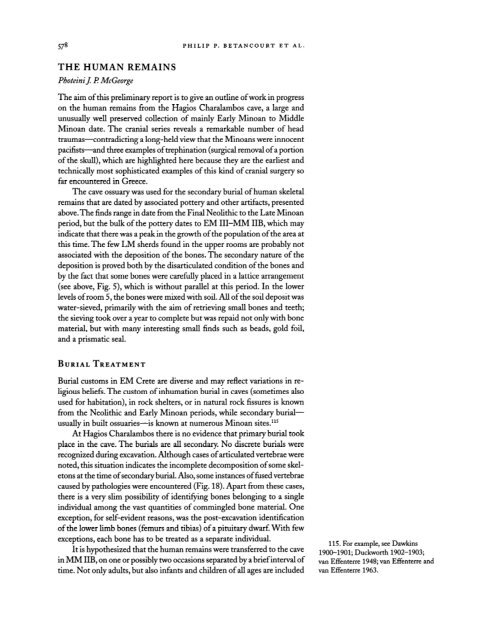Download - The American School of Classical Studies at Athens
Download - The American School of Classical Studies at Athens
Download - The American School of Classical Studies at Athens
Create successful ePaper yourself
Turn your PDF publications into a flip-book with our unique Google optimized e-Paper software.
578<br />
THE HUMAN REMAINS<br />
PhoteiniJ. P McGeorge<br />
PHILIP P. BETANCOURT ET AL.<br />
<strong>The</strong> aim <strong>of</strong> this preliminary report is to give an outline <strong>of</strong> work in progress<br />
on the human remains from the Hagios Charalambos cave, a large and<br />
unusually well preserved collection <strong>of</strong> mainly Early Minoan to Middle<br />
Minoan d<strong>at</strong>e. <strong>The</strong> cranial series reveals a remarkable number <strong>of</strong> head<br />
traumas - contradicting a long-held view th<strong>at</strong> the Minoans were innocent<br />
pacifists<br />
- and three examples <strong>of</strong> trephin<strong>at</strong>ion (surgical removal <strong>of</strong> a portion<br />
<strong>of</strong> the skull), which are highlighted here because they are the earliest and<br />
technically most sophistic<strong>at</strong>ed examples <strong>of</strong> this kind <strong>of</strong> cranial surgery so<br />
far encountered in Greece.<br />
<strong>The</strong> cave ossuary was used for the secondary burial <strong>of</strong> human skeletal<br />
remains th<strong>at</strong> are d<strong>at</strong>ed by associ<strong>at</strong>ed pottery and other artifacts, presented<br />
above. <strong>The</strong> finds range in d<strong>at</strong>e from the Final Neolithic to the L<strong>at</strong>e Minoan<br />
period, but the bulk <strong>of</strong> the pottery d<strong>at</strong>es to EM III-MM IIB, which may<br />
indic<strong>at</strong>e th<strong>at</strong> there was a peak in the growth <strong>of</strong> the popul<strong>at</strong>ion <strong>of</strong> the area <strong>at</strong><br />
this time. <strong>The</strong> few LM sherds found in the upper rooms are probably not<br />
associ<strong>at</strong>ed with the deposition <strong>of</strong> the bones. <strong>The</strong> secondary n<strong>at</strong>ure <strong>of</strong> the<br />
deposition is proved both by the disarticul<strong>at</strong>ed condition <strong>of</strong> the bones and<br />
by the fact th<strong>at</strong> some bones were carefully placed in a l<strong>at</strong>tice arrangement<br />
(see above, Fig. 5), which is without parallel <strong>at</strong> this period. In the lower<br />
levels <strong>of</strong> room 5, the bones were mixed with soil. All <strong>of</strong> the soil deposit was<br />
w<strong>at</strong>er-sieved, primarily with the aim <strong>of</strong> retrieving small bones and teeth;<br />
the sieving took over a year to complete but was repaid not only with bone<br />
m<strong>at</strong>erial, but with many interesting small finds such as beads, gold foil,<br />
and a prism<strong>at</strong>ic seal.<br />
Burial Tre<strong>at</strong>ment<br />
Burial customs in EM Crete are diverse and may reflect vari<strong>at</strong>ions in religious<br />
beliefs. <strong>The</strong> custom <strong>of</strong> inhum<strong>at</strong>ion burial in caves (sometimes also<br />
used for habit<strong>at</strong>ion), in rock shelters, or in n<strong>at</strong>ural rock fissures is known<br />
from the Neolithic and Early Minoan periods, while secondary burial -<br />
usually in built ossuaries - is known <strong>at</strong> numerous Minoan sites.115<br />
At Hagios Charalambos there is no evidence th<strong>at</strong> primary burial took<br />
place in the cave. <strong>The</strong> burials are all secondary. No discrete burials were<br />
recognized during excav<strong>at</strong>ion. Although cases <strong>of</strong> articul<strong>at</strong>ed vertebrae were<br />
noted, this situ<strong>at</strong>ion indic<strong>at</strong>es the incomplete decomposition <strong>of</strong> some skeletons<br />
<strong>at</strong> the time <strong>of</strong> secondary burial. Also, some instances <strong>of</strong> fused vertebrae<br />
caused by p<strong>at</strong>hologies were encountered (Fig. 18). Apart from these cases,<br />
there is a very slim possibility <strong>of</strong> identifying bones belonging to a single<br />
individual among the vast quantities <strong>of</strong> commingled bone m<strong>at</strong>erial. One<br />
exception, for self-evident reasons, was the post-excav<strong>at</strong>ion identific<strong>at</strong>ion<br />
<strong>of</strong> the lower limb bones (femurs and tibias) <strong>of</strong> a pituitary dwarf. With few<br />
exceptions, each bone has to be tre<strong>at</strong>ed as a separ<strong>at</strong>e individual.<br />
It is hypothesized th<strong>at</strong> the human remains were transferred to the cave<br />
in MM IIB, on one or possibly two occasions separ<strong>at</strong>ed by a brief interval <strong>of</strong><br />
time. Not only adults, but also infants and children <strong>of</strong> all ages are included<br />
115. For example, see Dawkins<br />
1900-1901; Duckworth 1902-1903;<br />
van Effenterre 1948; van Effenterre and<br />
van Effenterre 1963.
















